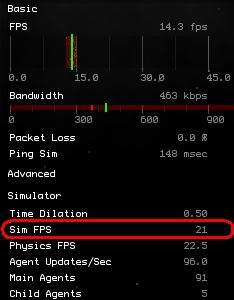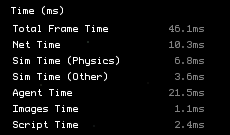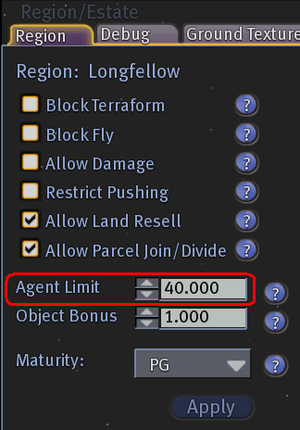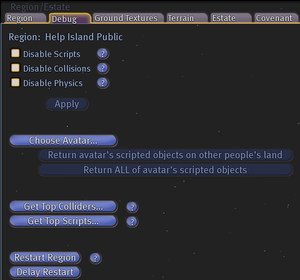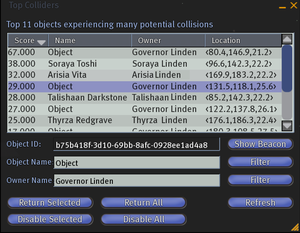Difference between revisions of "Region Performance Improvement Guide"
Rowan Linden (talk | contribs) |
|||
| Line 4: | Line 4: | ||
To see the performance of your Region you'll want to check the Region's Frames Per Second (FPS). To do this you can use the | To see the performance of your Region you'll want to check the Region's Frames Per Second (FPS). To do this you can use the | ||
[http://secondlife.com/app/help/guides/stats.php Statistics Bar]. While standing on your land select the View Menu > View Statistics Bar. This can be a bit overwhelming so we'll guide you through it. Note, Sim stands for Simulator and is another name for Region. In the Picture below we've circled the "Sim FPS", which is your | [http://secondlife.com/app/help/guides/stats.php Statistics Bar]. While standing on your land select the View Menu > View Statistics Bar. This can be a bit overwhelming so we'll guide you through it. Note, Sim stands for Simulator and is another name for Region. In the Picture below we've circled the "Sim FPS", which is your Region's Frames Per Second. | ||
[[Image:StatisticsBar_Initial.PNG|thumbnail|none]] | [[Image:StatisticsBar_Initial.PNG|thumbnail|none]] | ||
| Line 12: | Line 12: | ||
* 45 FPS: The best. No action necessary. | * 45 FPS: The best. No action necessary. | ||
* 35 - 44 FPS: This is good quite good and you don't need to tune if it never goes below 35 FPS. | * 35 - 44 FPS: This is good quite good and you don't need to tune if it never goes below 35 FPS. | ||
* 20 - 35 FPS: This is slow and should be noticeable. | * 20 - 35 FPS: This is slow and should be noticeable. Adjustment is needed to improve your Region's performance. | ||
* 10 - 20 FPS: This is bad and quite serious. | * 10 - 20 FPS: This is bad and quite serious. | ||
* 0 - 10 FPS: This is terrible. Time to open a Support Ticket. | * 0 - 10 FPS: This is terrible. Time to open a Support Ticket. | ||
If your performance of your Region is consistently over 35 FPS at its | If your performance of your Region is consistently over 35 FPS at its busiest time you can stop here. In the screenshot above, you'll notice the Sim FPS is 21, which means the Region is very slow. The Main Agents line shows 96, which is the number of Agents (Avatars) in your Region. As we'll discuss this is exceptionally high and is the prime cause of this Region's slow FPS. The Child Agent is the number of Avatars outside your Region that can see into your Region and also can slow your Region down if it is a significant number. | ||
To see more detail on what is slowing down your Region, expand the | To see more detail on what is slowing down your Region, expand the | ||
Revision as of 15:09, 23 October 2007
This article explains how to check your Second Life Region's performance and the steps you can take to improve it. This wiki was written for owners of Estates (Privately owned Regions) but mainland owners may find parts of it helpful.
Checking Your Region's Performance
To see the performance of your Region you'll want to check the Region's Frames Per Second (FPS). To do this you can use the Statistics Bar. While standing on your land select the View Menu > View Statistics Bar. This can be a bit overwhelming so we'll guide you through it. Note, Sim stands for Simulator and is another name for Region. In the Picture below we've circled the "Sim FPS", which is your Region's Frames Per Second.
To interpret the Sim FPS performance of your Region:
- 45 FPS: The best. No action necessary.
- 35 - 44 FPS: This is good quite good and you don't need to tune if it never goes below 35 FPS.
- 20 - 35 FPS: This is slow and should be noticeable. Adjustment is needed to improve your Region's performance.
- 10 - 20 FPS: This is bad and quite serious.
- 0 - 10 FPS: This is terrible. Time to open a Support Ticket.
If your performance of your Region is consistently over 35 FPS at its busiest time you can stop here. In the screenshot above, you'll notice the Sim FPS is 21, which means the Region is very slow. The Main Agents line shows 96, which is the number of Agents (Avatars) in your Region. As we'll discuss this is exceptionally high and is the prime cause of this Region's slow FPS. The Child Agent is the number of Avatars outside your Region that can see into your Region and also can slow your Region down if it is a significant number.
To see more detail on what is slowing down your Region, expand the Statistics Bar by clicking on the last line "Time (ms)" with your mouse to see the additional Region statistics shown below:
The "Total Frame Time" shows the number of milliseconds (ms) to display a single frame. Time greater than 22.2 ms means your Frame Rate will be below 45 FPS. For a detailed explanation of these see the knowledge-based article on the Statistics Bar and scroll to the section on Time.
Improving Your Region's Performance
There are a number of steps that you can take to improve your Region's performance. We've listed the steps in approximate order of the biggest impact and least effort but each Region is unique.
Reduce the Maximum Number of Avatars in Your Estate
The number of avatars in a region is the most common cause and usually the biggest contributor to low Region FPS. Lowering the maximum number of Avatars allowed in your Estate will usually increase your Estate's FPS. This can be done by selecting the World Menu > Region / Estate Menu Item. This will bring up the Region / Estate Window where you can adjust the Agent Limit field. Note: you must own the Estate or be an Estate Manager to adjust the Agent Limit field. The default number of avatars is 40 for a Region. Many Estates that suffer from poor performance have increased this number above 40. An avatar can see a maximum of approximately 30 other avatars. You can read the knowledge-based article on how to set the number of avatars in a region.
Remove Top Scripts
The most active scripts in your Region can slow it down. In the Statistics Bar, the Script Time line shows how many milliseconds your scripts are taking. If it is over 3 milliseconds then it may be worth investigating if this can be reduced. Too see which scripts are the most active, in your Estate, select the Debug Tab in your Region / Estate Window as shown below.
Then click on Get Top Scripts, which will bring up a Window shown below.
Hitting Refresh several times will capture different time slides and give a more accurate picture of the top scripts. Once you know which scripts are consuming your Region's resources, you can remove, replace or optimize them. Also, note that reducing the total number of scripts in your Region can improve performance.
Remove Top Colliders
The top colliders in your Region can slow it down. These are physical objects that are often moving and can contribute significantly to the time your Region takes to perform the physics calculations. In the Statistics Bar the Physics Time line shows how many milliseconds your physics is taking. If it is over 3 milliseconds then it may be worth investigating if this can be reduced. Too see which colliders are the most active, select the Debug Tab in your Region / Estate Window as shown below.
Then click on Get Top Colliders, which will bring up a Window shown below.
Since the top colliders list is based on a small time slide, its good to hit refresh a few times to get a more accurate picture. Once you know which objects are your top colliders, you can remove, replace or optimize them. Also note that removing the total number of moving objects in your Region can improve performance.
Remove Large Textures
Large textures greater than 512 x 512 can slow down a Region. In the Statistics Bar, the Images Time line shows how many milliseconds handling your Region's images is taking. If it is over 3 milliseconds then it may be worth investigating if this can be reduced. When an avatar views a large image or numerous smaller images for the first time since entering the Region, they will automatically download the image to their Viewer. If a number of avatar's are doing this at the same time then this will put a significant load on your Region, slowing down its FPS. If you can't remove these large textures then reducing the number of unique textures and size of the textures can increase your Region's performance.
Optimize Scripted Texture-Changing Objects
Scripted objects that change textures can also slow down a Region. Each time a new texture is displayed, it must be downloaded to each Avatar who is looking at the object. If you can't remove these objects then reducing the number of unique textures and size of the textures in these objects can increase your Region's performance.
Remove Big Prims
Big Prims greater than 10 m x 10 m can cause lag. Removing or reducing these in your Region can increase its performance.
Reduce the Number of Prims Used
Reducing the number of prims your Region uses will increase your Region's performance. Region's are currently limited to approximately 15,000 Prims.
Reduce Number of Objects
Large numbers of objects, especially if they are moving, rotating, flashing, scripted or emitting particles will slow your Region down.
Upgrade or Buy a Faster Region
There are different classes of Regions with different levels of performance. The fastest class of Region (Sim) can handle you to have more simultaneous avatars, more scripts, more physics, more objects and more textures in your Region at one time. Class 5 Sim/Region's are currently the fastest and were introduced in November 2006 with all new Sim/Region's thereafter being class 5. Class 5 Regions/Sims are described in Ian's post. The class is specified when we deliver it to you. For class 3 Estate owners you can upgrade to class 5. For class 4 Estate owners, who want a class 5, you will need to buy one. Of course, you can always sell your class 4 Estate.
